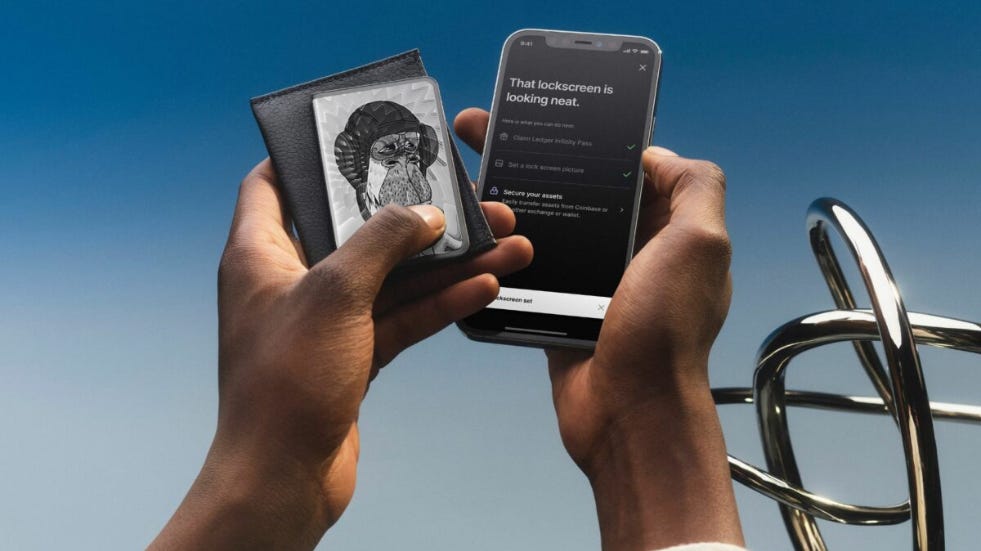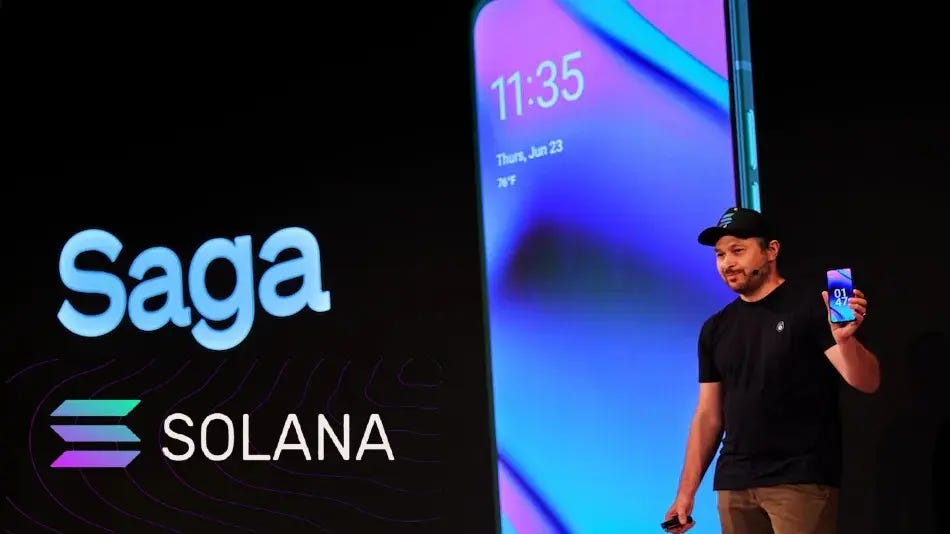Crypto Needs to Go Physical
The importance of web3 hardware.
Disclaimer, NFA, all that legal stuff: All the information presented in this publication and its affiliates is strictly for educational purposes only. It should not be construed or taken as financial, legal, investment, or any other form of advice.
Hi folks 🙋🏻♂️,
Amidst the ongoing mess in crypto, I found Ledger’s recent announcement of its new device extremely encouraging. Ledger, one of the most popular crypto hardware wallet companies, launched Ledger Stax, a new device designed by Tony Fadell, who was also the designer of iPod and Nest. Granted, you might not want to carry your net worth around in your pocket with a monkey picture that screams “please rob me”, but I guess you can purchase one for daily use and another as your safe deposit box. Long story short, the device is neat. It makes me think about the importance of solving web3 hardware problems and where the trends are going.
Today’s issue is brought to you by… Chain Catalyst
Chain Catalyst is the best newsletter for web3 builders and investors 📰
It covers the most relevant topics, three times a week, bringing web3 founders and investors up to speed with what's happening in crypto.
P.S. I’m an external advisor for Chain Catalyst.
Crypto Needs to Go Physical
Crypto has always been a digital-first industry. To most, crypto is fascinating because it lives almost entirely in the digital space, allowing it to combine all the unique aspects of finance, community, culture, governance, and technology into one giant interconnected ecosystem that spans jurisdictions. A DeFi developer in Thailand could create a decentralized exchange (DEX) with $8 billion in TVL at its peak — that DEX is then being utilized by hedge funds in New York to trade, by retail traders in India to swap synthetic forex currencies, and by a token project in the Middle East to pay their employees salary. You get the point.
That said, crypto’s potential will be limited if it only sticks to digital. We’ve already exhausted all of the digital-first potentials of crypto in the past two years. Sure, some metaverse IPs might work, but in order for crypto to truly reach the mass market and for dApps to have day-to-day use cases, a physical component is necessary.
In this write-up, I break down the current state of crypto hardware and the complex relationship that the crypto ecosystem has with incumbents such as Apple.
Here are the quick takeaways:
Crypto’s number one criticism is that no one really uses it.
For crypto to be widely used, it needs to adopt a mobile-first approach, which requires strong integration with existing mobile phone hardware makers.
Without crypto-native hardware solutions, the potential of crypto would always be limited by the incumbents’ willingness to adopt the technology.
For decentralized applications to truly become the bedrock for the next generation of the internet aka “web3”, it needs to be accessible by anybody with a mobile phone.
Proof-of-Physical-Work is an interesting concept that will increase in popularity as crypto solves its hardware problems and become more mobile-first.
iOS Dominance and Google’s Role
Earlier this month Coinbase Wallet made the news after it tweeted that Apple is forcing the company to remove its NFT sending functionality. The tech giant claims that the gas fees required to send those NFTs need to be paid through the iOS in-app purchase system so that Apple can collect its 30% cut. What a bunch of nonsense. Not only that this is technologically impossible, but it also shows how out of touch Apple is with the overall blockchain and crypto technology. Coinbase tweeted a good analogy:

Those who have been in crypto for some time, especially developers who are working on mobile solutions, know that the Apple Store has always been a pain to work with. Crypto is inherently financial technology, but Apple wants a 30% cut of every transaction routed on its ecosystem. This is a big screaming sign that the crypto ecosystem needs to work on its own hardware solutions, and fortunately, we’re seeing positive developments.
News broke that Apple will be forced to allow third-party App Stores for EU customers because of European regulation. Ironic how American capitalism-maximalist often said that the EU’s strong regulatory regime is an impediment to innovation, but that’s a topic for another post. The ability to have alternative App stores will unlock so much potential for decentralized applications. However, we can’t simply sit on our laurels and wait for Apple to be the good guy. There needs to be a simultaneous effort in pushing for crypto-native hardware solutions. An interesting prospect is the Solana phone.
In June 2022, Solana announced that it was developing a mobile phone called Saga. It will be an Android-based phone optimized for crypto users. Because Android is open source, it has always been easier to integrate custom applications on Android phones such as Samsung or Google Pixel. Another interesting idea: Google plans to be more involved with the blockchain space and Google Cloud will be adding BitQuery support for Solana in Q1 2023. Embracing the open-source nature of blockchain technology and integrating with the crypto ecosystem might be Google’s ploy to gain dominance over Apple in the mobile phone industry.
What if Ledger makes a phone? It’s not impossible given the company’s early start in becoming the premiere crypto hardware maker.
PoPW
There’s another interesting corner in the crypto hardware space: Proof of Physical Work (PoPW). The term was first coined by Multicoin Capital (no pun intended). In essence, PoPW refers to networks that build real-world infrastructure. This usually means that there’s a physical component involved.
Two notable examples are Helium and Hivemapper.
Helium incentivizes people to build and manage telecommunications networks via a hardware device that acts as micro-cell towers. Owners of these devices are in charge of creating coverage and transferring data all over the network. In return, they are rewarded with the network’s native token, HNT.
Hivemapper incentivizes people to build real-time map data with higher frequency via a hardware device that keeps track of the data. Owners of these devices can go through their daily lives and map the roads around them as they commute. In return, they are rewarded with the network’s native token, HONEY.
There are many more examples of PoPW networks. The premise is that it bridges the physical-digital space via tokens. Now imagine a perfectly working crypto-focused mobile phone that can run nodes, essentially making people all around the world active PoPW contributors at all times.
P.S. Alliance DAO wrote a great article on the topic, focusing on the factors to consider for founders that want to explore the PoPW space.


Personally, I think there are many use cases that can be explored with PoPW. That said, the success of these projects is fairly criticized thus far. Similar to other crypto tokenomics out there, PoPW networks often create a flywheel that amplifies the price of the token during a bull cycle, a vice-versa. It’s not inherently wrong because if Uber were to have its equity publicly trading before its IPO, you bet that it would’ve been extremely volatile too - doesn’t make Uber a scam.
Let’s Get Physical
The number one criticism that crypto gets is that it’s not really being used by your everyday users. In fact, the downfall of FTX doesn’t really impact the broader equities market or even the daily lives of most people. This is a talking point that has been conveyed by mainstream media to signal how insignificant crypto still is. Now that’s both a good thing and a bad thing, but one thing is clear. In order for crypto to power, the applications that are being used by your everyday users, it needs to get physical.
Child Prodigy
SBF got arrested. Seems like justice will be served. While it’s positive news for the FTX creditors who got hurt in the process, I can’t help to feel that it’s such a shame that somebody with so much potential can do so much harm to others (and himself) in such a short amount of time. Although SBF is 30 years old, his downfall reminds me of many child prodigies, specifically child actors and celebrities, who had messy lives because of too much fame and idolatry at such a young age. Case in point, Macaulay Culkin’s from Home Alone drug abuse, and Justin Bieber’s car crash. In SBF’s case, his fame and idolatry not only come from your average music and movie enjoyer but from literal world leaders and other billionaires. No matter how grounded you think you’re, such treatment from the world’s top 0.01% will eventually get into your head.
Until next time,
Marco M.








Apologies for the unfinished segment in today's email (its fixed on Substack), my internet went down as I was putting the finishing touches.